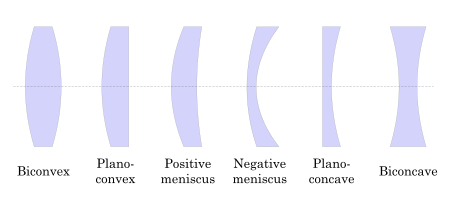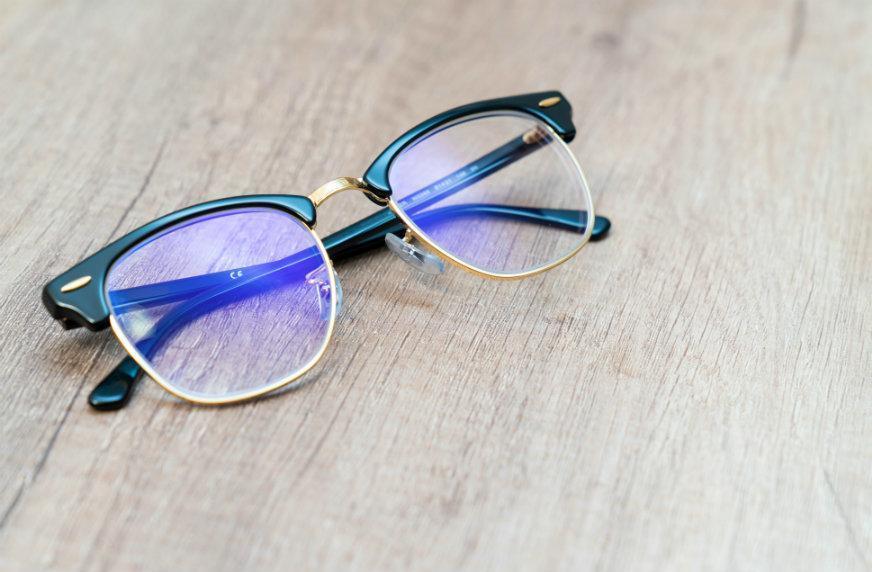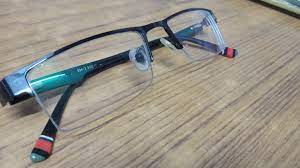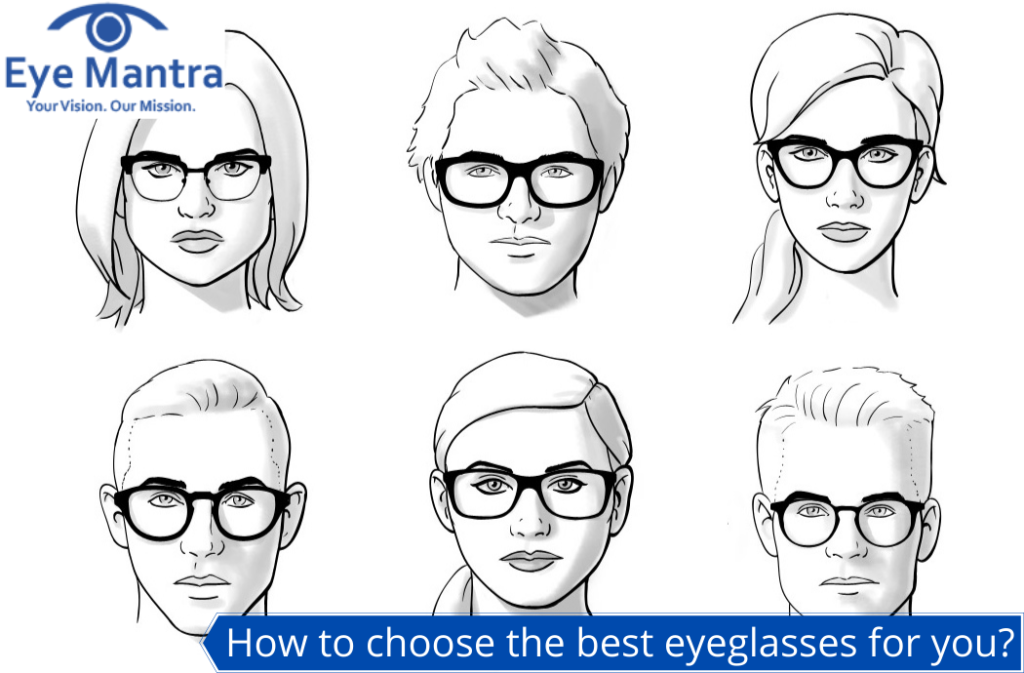Contents
Parts of Eyeglasses
Eyeglasses though have a simple structure but are composed of different parts. The eyeglasses are made up of nine parts in total.

- Rim
It is the part that holds the lens in place. It is also the part that makes the framework of eyeglasses. The rim of the eyeglass can be made of different materials like steel, plastic, etc, which can fit the needs of the user.
- End Pieces
They are the end part of the rim. They are placed as an extension of the rim and connect the rim to the temple.
- Bridge
It is a connecting link between the two rims of either lens. It rests on top of your nose.
- Hinges
The hinge is the part of the eyeglass in which the rim of the lens and temple are connected. The temple can be folded inside using the hinge.
- Lenses
It is clear pieces of glass or plastic that are made in order to view clearly. The rim holds the lenses.
- Screws
They connect the end piece with the temple.
- Nose Pads
They are made up of plastic to sit on the nose. They are connected to the bridge of the eyeglasses.
- Pad Arms
The pad arms are the connecting link between the bridge and the nose pads. They can be adjusted in a manner that the eyeglass can sit comfortably on your nose.
- Temples
They are the long arms that sit on the ear to provide a proper fitting of the eyeglasses.
All these parts make up an eyeglass. According to the needs of the customer, the eyeglasses can be customized. The material and shape of the eyeglasses can be altered according to the use of the customer.
Types of Lens Used In Eyeglasses
Eyeglasses have become more than the vision corrector. They are being used in fast fashion and some people like to wear them to look cool and studious. In order to achieve certain requirements laid by the user of the eyeglasses, you should know which material type of lenses is more suitable for your needs.
Glass Lenses
Eyeglasses were earlier only available in the glass material and didn’t have a variety of materials to choose from. As the technology developed the material of the lenses used in eyeglasses also changed. Eyeglasses made from glass had a major disadvantage of being heavy and if not taken proper care then they would fall and break requiring a new replacement. To eliminate these disadvantages the lenses are now being made light and have a variety of features from being scratch resistant to impact resistant.
Plastic Lenses
Plastic lenses were introduced as a replacement to the glass lenses. They were light and were half the weight of the initial glass lenses. They were also cost-effective and were widely famous for their properties. Progression in the technology took place and lenses made up of polycarbonate were introduced.
Polycarbonate Lenses
Polycarbonate lenses are lightly weighted and give built-in UV protection. They are considered suitable for the people who are into sports activity or do rough handling of the eyeglasses. They are worn mostly by the kids and are also used in safety glasses and sports eyewear. Trivex lenses were similar to polycarbonate lenses. They are also lightweight and thin but along with that they also provided scratch-resistant and vision correction.
High Index Plastic Lenses
High-index plastic lenses are the lenses that are used in the higher index prescription. Earlier thick eyeglasses were used for the higher index prescription but these high index lenses are thin and lighter than the old ones.
Aspheric Lenses
Aspheric lenses have various degrees of curvature which means they can be thinner and flatter so you can use a much larger portion of the surface.
Photochromic Lenses
Photochromic lenses are the lenses that turn tinted when kept in sunlight and turn clear when there is an absence of sunlight. These lenses block UV rays and eliminate the need of getting sunglasses.
Lenses Based On Their Shape
According to your vision problem, you’ll need a concave lens (curves inward) if you’re near-sighted, a convex lens (curves outward) if you’re farsighted and for astigmatism, your cornea is shaped wrong, so your lenses may be more like a cylinder or mixture of a concave and convex lens.

Lenses With Different Focal Points
Also, there are single focal, bifocal, trifocal, progressive lenses available which are selected based on the eye condition that you have. If you only have either near-sightedness or far-sightedness then you will need a single focus lens in your eyeglass. But if you have both the condition then the bifocal, trifocal, or progressive lens can be used according to the prescription prescribed by an ophthalmologist.
Bifocal lenses are the lenses prescribed to people having presbyopia. In these lenses, the lower part of the lens is used to view the objects placed nearby whereas, the upper part of the lens is used to view the objects placed a far away.
The trifocal lens provides the same type of vision as a bifocal lens but it also has the presence of an intermediate lens which helps to change the vision with much ease. The progressive type of multifocal lenses is the advanced lenses type. They have the upper part of the lens which is used to view the distant objects and as you go to the lower side of the lens there is progression to the reading vision present.
In progressive lenses, the prescription gradually changes from distance to near vision. They also do not have a distinction between the different lenses used for different vision which makes them more convenient to use.

- Other Types of Lenses
There are eyeglasses made to use for very specific purposes like reading and using the computer. If you work long hours in front of the computer then it is always advised to use the computer eyeglasses. These eyeglasses are helpful in blocking the harmful blue light radiating from the computer or the laptop screen. The reading eyeglasses are used for the reading purpose and help in reducing the eye strain caused by the long hours of reading books in low light condition.
Coating On Eyeglasses
The protective coating on the lenses of the eyeglasses helps in providing a more strain-free vision. These protective coatings can be introduced as a film on your lens. Though most of the lens comes with the in-built scratch-resistant and UV protective coat. But the lenses which don’t have an in-built version then it becomes necessary to get these protective coatings on the lenses.

Anti-Scratch Eyeglasses Coating
The lenses have a soft outer layer which makes them prone to scratches if proper care is not given. In such conditions use of anti-scratch coating can help increase the durability of the lens and would also make the lenses scratch-resistant like the glass lenses. If your lens already has in-built scratch resistance then you don’t have to get a scratch-resistant coating for your lens.
Anti-Reflective Coating
It helps in reducing the glare, halos of the light to make the vision clear in the presence of the light. This coating is generally helpful for people who have light sensitivity and find trouble while driving at night. They also prevent the formation of reflection on the eyeglass making it easier for the person sitting in front of you to talk and maintain eye contact.
UV Coating
This coating helps in providing protection from the harmful rays of the sun. Some of the lenses already have pre-installed UV protective coating and do not require an additional coat of the film.
Photochromic Coating
This type of coating eliminates the need of getting separate sunglasses as the lens becomes tinted when present in sunlight and becomes transparent again when there is the absence of sunlight. It is helpful for the people who have fieldwork. Sometimes the lens does not detect the change in the environment and takes time to change the tint of the lens which is a major disadvantage of photochromic lenses.
Types of Frame Material of Eyeglasses
People tend to choose eyeglass which is lightweight, sturdy, and is corrosion-free. The eyeglasses are made from different plastics and metals and come in a wide range of variety that you can choose from.

Metal Frames
Metal frames are mostly made from a combination of different types of metals which provide them lightweight and are corrosion-free. Titanium frames are frames that are lightweight, strong, and are corrosion-free. They are most suitable for children or for ones who are rough on their eyeglasses. Beryllium frames are also metal frames and are less costly than titanium frames. They are lightweight, flexible, and corrosion-free.
Stainless steel frames also provide the same functions but are not light weighted as much as the beryllium and titanium frames. Flexon is an alloy of titanium and is used in the frames of eyeglasses. If the frame gets twisted up then it comes back in its original shape. This type of frame is more suitable for children. Aluminium is used in high-end frames and is strong, light-weighted, and corrosion-free.
Plastic Frames
Plastic frames are also available for the eyeglasses frame. Plastic frames are not as sturdy as metal frames but are available in a wide range of colours and are soft on the skin. They are also inexpensive when compared with metal frames. The different types of plastic frames are Zyl, cellulose acetate propionate, blended nylon, and optyl. The plastic frames are easily moldable according to your face shape. They are also inexpensive making them suitable for children to use.
Rimless Frames
Rimless eyeglasses are also available. In these types of eyeglasses, the lenses are attached to the bridge and end pieces with the help of screws. They give a frameless look to the eyeglasses. Trivex or polycarbonate lenses are used for such eyeglasses.
How To Maintain Eyeglasses
The eyeglasses that you selected for yourself took your time. It is important to make these eyeglasses last longer so that you don’t have to go back to this trouble again. To make the eyeglasses last longer take proper care of them.
- Always rinse your eyeglasses before cleaning them or wiping them off. Dust and dirt particles if wiped without rinsing the eyeglasses then they may get collected in the corners of the rim and would become abrasive.
- If you use a spray to clean your eyeglasses then make sure you use eyeglasses cleaner spray only. The spray from which household glasses are cleaned should not be used as it may remove the coating present on your eyeglasses.
- Never use paper towels, tissue, or napkins to clean your lenses. They have rough surfaces and can scratch the lenses easily. Avoid using your cloth for the same. Use lint-free cloth or cloth which is 100% cotton.
- Hold your eyeglasses from the bridge while cleaning. Holding it from the temple can cause a change in the shape of the eyeglasses and will cause discomfort while wearing them.
- When you are not wearing your eyeglasses then store them properly. This will help in keeping the dirt and dust away from the lenses. Small microfibre cases are available if you don’t like the big bulky cases.
- Never lay your glasses on the lens side as this may cause scratches on the lens.
- Wash your eyeglasses at least once a day to keep them in their optimal state.
- Avoid pushing your eyeglasses to your head as it causes the frames to widen and then will ultimately be loose on you.
- If you lose or misplace your eyeglasses then attaching a cord to them will solve this problem. The cord will help you to either hang your eyeglasses in your pocket present on the shirt or will just hang around your neck.
- Before buying any kind of eyeglasses visit to an optometrist or ophthalmologist is necessary as they would help you decide which type of lenses would be good for you according to your usage.
- For screen use, computer glasses should be worn and reading glasses should not be used for viewing screens. The eyeglasses that you wear should be light weighted, comfortable, strong, and should not cause any eye strain.



